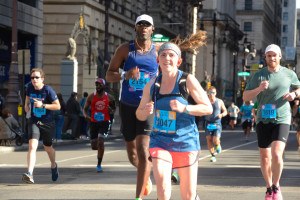The Biggest Running Mistakes You’re Making (And How to Fix Them)
Raise your hand if you are training for the Philadephia Marathon in November — or for any race, for that matter. Okay, first, let me just say: You are a beast. And second, you’re going to want to take note of this running advice to remedy the biggest and most common running mistakes out there, according to Charles Scogna, owner, trainer and running coach (he’s quite the renaissance man) at CHARGE Performance and Wellness in Bella Vista.
And speaking of running advice, you’ll find plenty more of it at CHARGE Running, Scogna’s new training group for runners who are looking for regular input from a pro. The group will meet three times weekly starting October 3rd, with sessions covering everything from agility and weight-training (Monday evenings) to gait and speed work (Thursday mornings) and gym training sessions followed by long runs — followed by brunch (Saturdays). The cost to join CHARGE Running ranges from $54 per month to $150, depending on how often you attend. He also has a slew of Charge Running events on the roster. You can learn more here.
Now, back to that advice we were talking about: Below, you’ll find the top five running mistakes, according to Scogna, plus how to stop making them once and for all.
1. You aren’t checking yourself before you run — which means you may wreck your run.
Chances are, one day, you thought to yourself, I’m going to start running today! And then you did. Which is great — you’re clearly a human who gets things done. But Scogna says one big mistake he sees runners make is not getting their stride looked at by a pro before they hit the pavement.
He puts it like this: If you don’t know what your starting point is and what your stride and posture look like along with what improvements you should make to them, then, “just like a car with a bent axel, you’ll wear out your wheels pretty quickly.”
Scogna’s suggestion: Either take a video of yourself or have a running coach take of a video of you from the side to see what your posture and joints are up to, then soak in all the running coach’s valuable feedback. Think of it as a tune-up — for your run.
2. You’re forgetting about your feet.
Nope, he’s not talking about your shoes: As Scogna says, many runners pay attention to their shoes but then forget about their feet completely, rolling them on a golf ball for two minutes every now and calling it a day. But ignoring your feet is a big mistake. As he explains, your feet “are the first things that hit the ground and tell the rest of your body what to do.” So strengthening them is just about as crucial as salting avocado toast. Read: VERY crucial.
So, how does one go about strengthening their feet? Well, Scogna’s favorite foot-strengthening move involves looping your two big toes into the same rubber band, then fanning your feet away from each other. “The rubber band allows you to spread your toes; it really wakes up your muscles. It’s a great move to do before or after a run.” You can find a video of Scogna demonstrating the move here.
3. You’re keeping your movement too basic.
Standing upright and moving forward (so, uh, running) is pretty standard for us humans, Scogna says. In order to up your running game, you need to sharpen your central nervous system — the system that tells the body what to do — by challenging it. That means moving in ways that aren’t just upright and forward. “Seek out creative ways to move sideways and in rotation, move over new surfaces, and have a professional guide you to more advanced training,” Scogna suggests.
Working exercises like bear crawls and lateral lunges into your training is a good place to start, Scogna says.
4. You’re not strength training often enough — and you’re not strength training above your bodyweight.
You can only move what your body is used to moving, Scogna points out. So if you aren’t working strength training into your workout schedule, you’re limiting your running skills. After all, “the stronger your muscles get by moving more weight than your bodyweight, the faster they can move your body.” Which means the more likely you are to get to the finish line faster this time around than you did last year.
If you are a runner who’s currently wondering, “Uh, WTF is strength training, anyway?” Scogna suggests starting with bodyweight exercises (think: squats, lunges, and so on), then, once you’ve got the hang of ’em, adding weight. For instance, trying a goblet squat with a kettlebell. The idea is, the stronger you get, the more supporting the weight of your body during a race will become an afterthought. Scogna offers up a primer of strength training for running here.
5. You’re too shortsighted.
It’s easy to get wrapped up in the running goals you want to conquer over the next few months, like breaking your PR during the Philadelphia Marathon. But solely focusing on your short-term goals can screw with your long-term goal of, uh, being a badass runner forever. After all, if you beat your body up too much in pursuit of your PR, it probably won’t be so enthusiastic next time around.
Then there’s the flip side of this. Some runners look at short-term goals they want to accomplish, decide they’ll never be able to reach them, and give up on running completely. Scogna says this isn’t the answer either; just because you aren’t an Olympic runner doesn’t mean you won’t reach your potential with a solid training plan.
So, Scogna’s advice — which lends itself well to just about everything we do in life, by the way: Consider the runner you want to be in two, five and 10 years from now, make a smart and solid plan to reach the goals interspersed throughout those years, respect your body, and run forever instead of wearing yourself out or scaring yourself out of the running game by trying to reach unrealistic goals.
Like what you’re reading? Stay in touch with Be Well Philly—here’s how:
- Like Be Well Philly on Facebook
- Follow Be Well Philly on Twitter
- Follow Be Well Philly on Pinterest
- Get the Be Well Philly Newsletter



